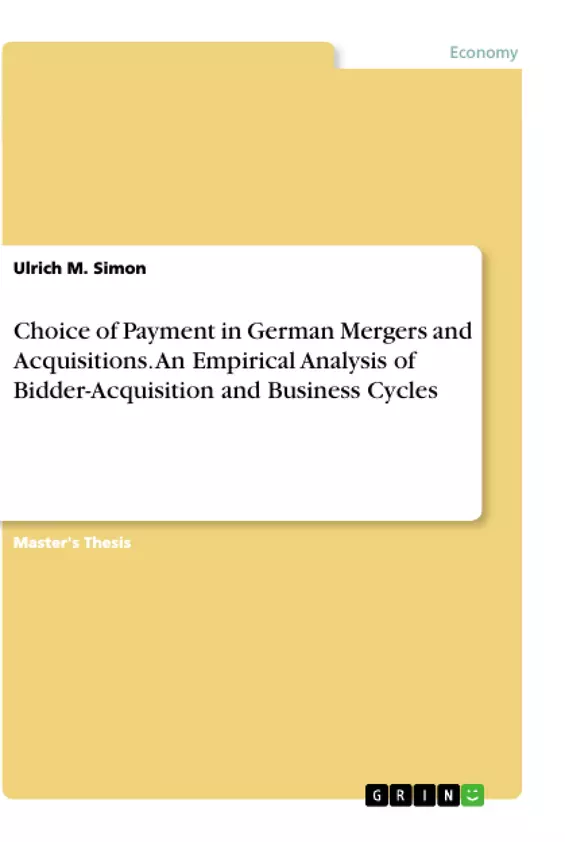This thesis investigates the choice of payment method in German M&A. It aims at identifying which determinants are most influential in explaining the choice of payment method in German M&A. The focus, thereby, is on bidder-, acquisition-, and business cycle characteristics. To provide empirical evidence, 207 German acquisitions conducted during January 2003 to December 2010 are closely studied.
Mergers and Acquisitions (M&A) are among the most important and influential investment decisions made by a company. Consequently, M&A have attracted immense attention from both academics and professionals. Among the various topics that have been studied in M&A, the method of payment has been the subject of numerous researches both theoretically and empirically. These studies highlight that the method of payment is one of the most critical elements of the M&A process and its choice may well determine both the ability to complete the acquisitions and the future success of the merged entities.
The choice of payment method in mergers and acquisitions (M&A) has significant diverse implications for the bidder, the target, and the shareholders of both parties. Therefore, it is driven by distinct factors. This becomes evident when examining the choice of payment method in M&A more closely. Consistent with earlier empirical studies, the logistic regressions'analysis shows that there are several characteristics that affect the choice of payment method. Particularly, the findings suggest that the characteristics of the bidder are most influential in determining the payment method for German M&A. That is to say, the larger a bidder’s total assets, a bidder’s cash holdings, and the relative size of the bidder to the target, the higher the probability of cash payments in German M&A. On the contrary, the higher a bidder’s leverage ratio and the higher a bidder’s tangible assets, the more likely share payments are employed. In addition, a rising stock market index also indicates a higher probability of cash payment in German M&A. Overall, the findings of this paper corroborate common theories and empirical studies. However, similar to other studies on the choice of payment method the analysis shows inconsistent results for some characteristics. This can be partly explained by country-specific characteristics. However, it can also be justified by the selection of the samples, the time, and the undertaking of the study.
Inhaltsverzeichnis (Table of Contents)
- INTRODUCTION
- THE GERMAN MERGERS AND ACQUISITIONS MARKET
- PROBLEM DEFINITION
- FUNDAMENTALS AND THEORETICAL BACKGROUND
- MERGERS AND ACQUISITIONS
- MERGERS AND ACQUISITIONS TRANSACTION PROCESS
- PAYMENT METHODS
- CASH PAYMENTS
- SHARE PAYMENTS
- MIXED PAYMENTS
- OTHER PAYMENTS
- METHOD OF PAYMENT VS. MODE OF FINANCING
- THEORETICAL BACKGROUND OF THE PAYMENT METHOD
- ASYMMETRIC INFORMATION
- TAXATION
- LITERATURE REVIEW AND HYPOTHESES
- CHARACTERISTICS OF THE BIDDER
- CORPORATE CONTROL HYPOTHESES
- FINANCIAL LEVERAGE HYPOTHESIS
- DEBT CAPACITY HYPOTHESES
- CASH AVAILABILITY HYPOTHESIS
- RELATIVE SIZE HYPOTHESIS
- INVESTMENT OPPORTUNITIES HYPOTHESIS
- STOCK PERFORMANCE HYPOTHESIS
- CHARACTERISTICS OF THE ACQUISITION
- CROSS-BORDER HYPOTHESIS
- CROSS-INDUSTRY HYPOTHESIS
- UNLISTED TARGET HYPOTHESIS
- CHARACTERISTICS OF THE BUSINESS CYCLE
- MARKET PERFORMANCE HYPOTHESIS
- OVERVIEW OF HYPOTHESES
- DATA AND DESCRIPTIVE STATISTICS
- DATA
- DESCRIPTIVE STATISTICS
- METHODOLOGY
- BINARY LOGISTIC REGRESSION
- MULTINOMIAL LOGISTIC REGRESSION
- PRECONDITIONS FOR THE LOGISTIC REGRESSION
- RESULTS
- BINARY LOGISTIC REGRESSION
- CASH PAYMENTS VS. SHARE PAYMENTS
- CASH PAYMENTS VS. MIXED PAYMENTS
- SHARE PAYMENTS VS. MIXED PAYMENTS
- MULTINOMIAL LOGISTIC REGRESSION
- CRITICAL REFLECTION
- CONCLUSION
Zielsetzung und Themenschwerpunkte (Objectives and Key Themes)
This master thesis investigates the choice of payment method in German mergers and acquisitions (M&A), aiming to identify the most influential determinants. The focus is on bidder-, acquisition-, and business cycle characteristics. The objective is to analyze empirical data from 207 German acquisitions between January 2003 and December 2010.
- Examining the choice of payment method in German M&A.
- Identifying key determinants influencing the choice of payment method.
- Analyzing the impact of bidder characteristics, such as financial leverage, asset size, and cash holdings.
- Investigating the role of acquisition characteristics, such as cross-border transactions and target listing status.
- Assessing the influence of business cycle characteristics, such as stock market performance.
Zusammenfassung der Kapitel (Chapter Summaries)
Chapter 1 introduces the German M&A market and its historical development, highlighting its significance and key drivers. Chapter 2 defines M&A and its transaction process, providing a detailed explanation of various payment methods, including cash, shares, and mixed payments. This chapter also discusses the relationship between method of payment and mode of financing. Chapter 3 reviews existing literature on the choice of payment method, identifying key determinants and formulating hypotheses based on previous research. Chapter 4 presents the dataset used in the analysis, including data sources, selection criteria, and descriptive statistics. Chapter 5 outlines the statistical methods employed in the study, including binary and multinomial logistic regression models.
Schlüsselwörter (Keywords)
The main keywords of this thesis include mergers and acquisitions, payment methods, cash payments, share payments, mixed payments, bidder characteristics, acquisition characteristics, business cycle characteristics, logistic regression, and German M&A market. The research focuses on identifying the factors that influence the choice of payment method in German M&A, drawing insights from existing theoretical frameworks and empirical studies.
- Quote paper
- Ulrich M. Simon (Author), 2011, Choice of Payment in German Mergers and Acquisitions. An Empirical Analysis of Bidder-Acquisition and Business Cycles, Munich, GRIN Verlag, https://www.grin.com/document/590667



